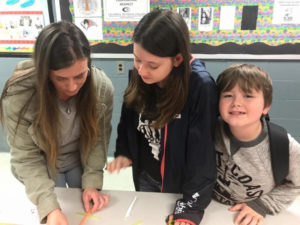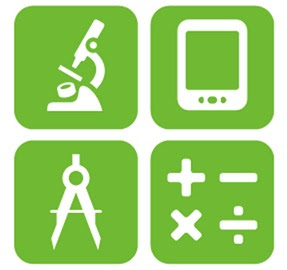Success Stories - November 2018
5 Keys to Creating a School-Wide STEM/STEAM Culture
By Stacy Day, EdS, Principal, Arnold Magnet Academy
I believe that creating a truly effective STEM/STEAM learning environment in a school or school system requires a cultural shift. STEM/STEAM is a transdisciplinary approach to education that not only includes Science, Technology, Engineering, the Arts, and Science, but it embodies the 4 C’s of 21st Century Learning (Communication, Collaboration, Critical Thinking, and Creativity). STEM/STEAM education must contain real-world problem solving and a connection to careers
Arnold Magnet Academy in Columbus, Georgia has been a Mathematics, Science, and Technology Magnet School within a school since 2001. We are a grade 6-8 Middle School. I began my mathematics teaching career in this school that same year and the next nine years were spent building a strong program. I then became an Assistant Principal at an IB School where I spent the next four years, then returned to Arnold as Principal. To my dismay in returning, the magnet program had been to some degree unrecognizable from my prior experience.
So, with the goal of becoming a Georgia STEM Certified Middle School as my North Star, began the process of changing the culture of the Arnold Magnet Academy and rebuilding our STEM/STEAM program. Here are five keys to our culture shift:
- Develop a strong mission and vision using a common language and align to the strategic plan
Communication to all stakeholders is a must using the “Why” not the “What”. Why are we creating a STEAM culture? Our reason is because it is the right focus for our students to prepare them for the modern workforce. At the Arnold Middle School, we are working hard to prepare our students for many possible careers, but are emphasizing sustainable energy careers, as that is a core industry in our local community.
A school’s focus must connect students to real problems school-wide, locally and globally. We are preparing students today for jobs that do not yet exist. Selecting the topic of focus must be broad enough to have multiple problems to solve across grade levels.
- Start small and build from there, but provide comprehensive professional development and resources along the way
STEM/STEAM is not a one and done lesson. The first year of our school’s transformation, I asked teachers to deliver one STEM lesson on Georgia’s STEM day in May. This was to evaluate their interpretation of STEM. I observed all classrooms and evaluated the lesson plans.
From the collected data, I planned the second year professional development centered on the topic of problem-based instruction.
The second year, two STEM lessons were delivered, one in December and one in May. By this point in our journey, I felt as if we needed some additional outside expertise, so we sought out external support from Discovery Education, one of the leading providers of k-12 digital resources and professional development. In partnership with Discovery Education, we launched a three year comprehensive professional development plan called STEMformation.
 Get the right people properly placed to do the work
Get the right people properly placed to do the work
When I interview candidates for a teaching position, the first question that I ask is “Why middle school?” Middle school is not always about curriculum, but about developing the whole child. I also look for passion for teaching and learning. It is a must that the teachers have a passion for this age child and educating them. I then share my STEAM vision for the school with passion and enthusiasm. If the individual exhibits a passion for teaching middle school students and is buys-in to the vision for STEAM education at the Arnold Magnet Academy, it is a good bet they are a great candidate for our team.
Next, find that enthusiastic, passionate teacher or academic coach and appoint him or her a STEM/STEAM Coordinator. I am fortunate to have an academic dean who is my coordinator.
Lastly, it requires the proper placement of teachers for the daily work. My best teachers are teaching in our STEM Magnet.
- Build great relationships within the school
Students learn best in an environment where they are known, valued, and inspired, which is part of our school district’s mission statement. So, we spend the first week of school and the first 3 days after winter break on team building and expectation setting. We are a Positive Behavioral Interventions and Supports school with on-going professional development. Teachers build healthy relationships with students that create a climate of teamwork and trust in the building and support our STEM/STEAM culture. Students need to have a growth mindset without fear of failure—therefore, we always emphasizes that FAIL stands for First Attempt in Learning.
Administration must build open, positive relationships with teachers, students, parents, business partners, and other stakeholders. I present information to all stakeholders with passion and enthusiasm. I support my teachers by finding the resources that are essential to meet the needs of our students.
- Develop key partnerships within the community
Our partner-in-education is Liberty Utilities, a gas company, who has sister companies around the nation in other energy sectors. In addition, we also work with Georgia Power, another regional utility company. Both support us by presenting lessons related to the curriculum.
We also schedule field trips to local our university, Columbus State University, and our local technical college, Columbus Technical College, during which students learn about a variety of career opportunities. In the near future, we’ll add a university tour program as well.
Arnold Magnet Academy also holds an annual Career Day, which is another opportunity for our students to learn more about jobs in our area, as well as hold a STEM family night and Saturday as well as a two day camp in the summer. These opportunities help us reach parents and other community stakeholders and share additional information about how we are helping their children prepare for the future.
Our district’s Career, Technical and Adult Education (CTAE) department supports our students’ efforts to learn about robotics and coding and TSYS Payment Solutions, a credit card processing company whose home office is in Columbus, also provides our students with a variety of rich learning opportunities.
While these five keys have helped us unlock the tremendous potential of the Arnold Magnet School educators and students and build a robust culture of STEM/STEAM teaching and learning, there are additional ways to drive STEM education a magnet setting. Leave your ideas in the comments section below.
Stacy Day, EdS, is the Principal of the Muscogee County School District’s Arnold Magnet Academy, which located in Georgia. You can reach her at: Day.Stacy.S@muscogee.k12.ga.us.

 Get the right people properly placed to do the work
Get the right people properly placed to do the work